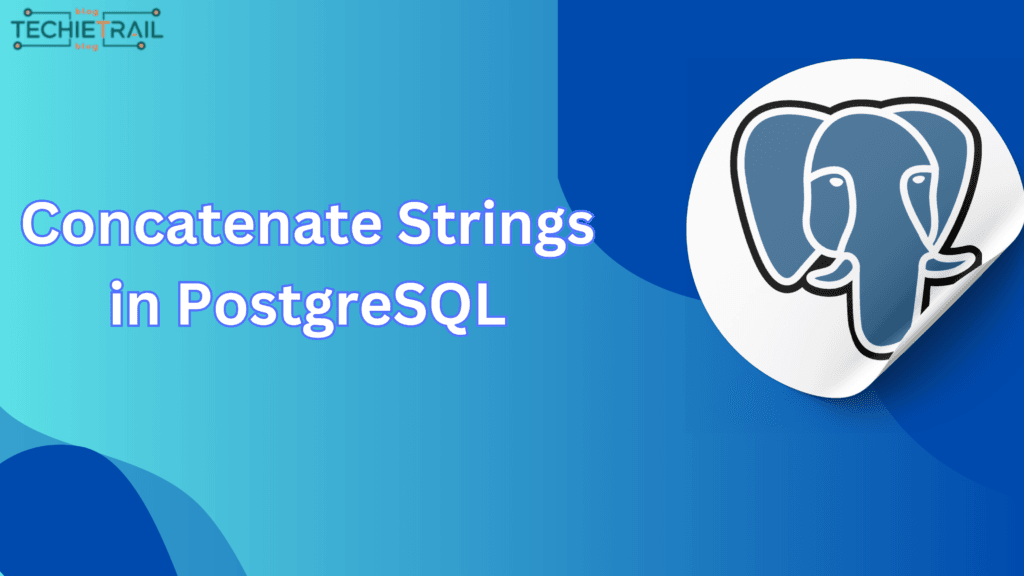String concatenation is a common operation when working with databases. PostgreSQL provides powerful tools to combine strings into a single output. Whether you’re creating a dynamic query, formatting data, or simply merging columns, PostgreSQL offers several methods to perform string concatenation effectively.
In this blog, we’ll explore how to concatenate strings in PostgreSQL with practical examples and tips for better utilization.
What Is String Concatenation?
String concatenation involves combining multiple strings into a single string. For example, combining “Techie” and “Trail” results in “TechieTrail“.
In PostgreSQL, you can concatenate strings using:
- The || Operator
- The CONCAT Function
- Custom Formatting with CONCAT_WS (Concatenate with Separator)
Let’s dive into each method with examples.
1. Concatenation Using the || Operator
The || operator is the simplest way to concatenate strings in PostgreSQL.
Syntax:
string1 || string2 || string3Example:
SELECT 'Hello' || ' ' || 'World' AS concatenated_string;Output:
Hello WorldIf you’re working with dates in PostgreSQL and need to calculate differences between them, check out our detailed guide: What is DATEDIFF in PostgreSQL.
Usage with Columns:
Suppose you have a table named employees with columns first_name and last_name. You can concatenate them to create a full name:
SELECT first_name || ' ' || last_name AS full_name FROM employees;Output:
John Doe
Jane SmithThis method is fast and straightforward, but it requires manually adding spaces or separators.
2. Concatenation Using the CONCAT Function
PostgreSQL’s CONCAT function allows you to combine multiple strings without worrying about NULL values.
Syntax:
CONCAT(string1, string2, string3, ...)
Example:
SELECT CONCAT('Hello', ' ', 'World') AS concatenated_string;Output:
Hello WorldUsage with Columns:
SELECT CONCAT(first_name, ' ', last_name) AS full_name FROM employees;Even if one of the columns is NULL, CONCAT will skip it instead of returning NULL.
3. Concatenation Using CONCAT_WS
The CONCAT_WS function allows you to specify a separator for concatenation. This is especially useful when dealing with CSV-style outputs.
Syntax:
CONCAT_WS(separator, string1, string2, string3, ...)Example:
SELECT CONCAT_WS('-', '2024', '11', '28') AS formatted_date;Output:
2024-11-28Usage with Columns:
To create a comma-separated full name:
SELECT CONCAT_WS(', ', last_name, first_name) AS formatted_name FROM employees;Output:
Doe, John
Smith, Jane4. Handling NULL Values in Concatenation
When using the || operator, if any part of the concatenation is NULL, the entire result will be NULL. To avoid this, use COALESCE.
Example:
SELECT first_name || ' ' || COALESCE(middle_name, '') || ' ' || last_name AS full_name FROM employees;Here, COALESCE replaces NULL with an empty string, ensuring the result is not NULL.
5. Combining Strings Across Multiple Rows
For concatenating strings across multiple rows, PostgreSQL provides the STRING_AGG function.
Example:
SELECT STRING_AGG(first_name, ', ') AS all_first_names FROM employees;Output:
John, Jane, Sarah6. Practical Examples
Concatenating Address Fields
If you have columns street, city, and state, you can combine them into a single address:
SELECT CONCAT_WS(', ', street, city, state) AS full_address FROM addresses;Output:
123 Elm St, Springfield, ILGenerating URLs Dynamically
SELECT 'https://www.techietrail.com/profile/' || user_id AS profile_url FROM users;Output:
https://www.techietrail.com/profile/101Generating Dynamic Data with Dates
String concatenation can be combined with date functions for generating formatted outputs or logs. For instance, you can create dynamic reports where dates are part of the output:
SELECT CONCAT('Report for ', CURRENT_DATE) AS report_message;If you’re working with dates in PostgreSQL and need to calculate differences between them, check out our detailed guide: What is DATEDIFF in PostgreSQL.
Performance Considerations
- Indexes: If you concatenate columns frequently in queries, consider creating a computed column or materialized view to improve performance.
- NULL Handling: Always account for NULL values to avoid unexpected results.
Why Use CONCAT in PostgreSQL?
- Flexibility: Easily handle different data types.
- Readability: Code is cleaner compared to || for multiple strings.
- Error Handling: Skips NULL values gracefully.
Conclusion
String concatenation is a fundamental operation in PostgreSQL, and mastering its different methods can significantly enhance your database queries. Whether you’re building full names, creating URLs, or generating reports, PostgreSQL provides powerful tools like ||, CONCAT, and CONCAT_WS to meet your needs.
If you’re looking to simplify your operations, make use of these techniques and explore how concatenation can streamline your PostgreSQL workflows.
For more database tips and tutorials, visit TechieTrail—your hub for coding and tech insights!



